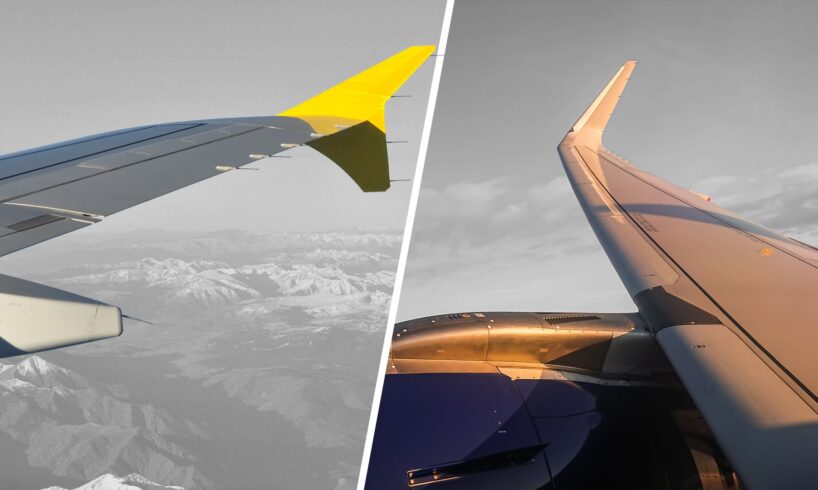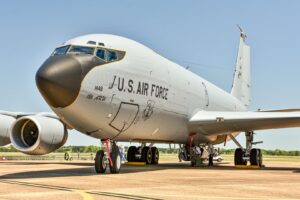
Looking at any of the existing variants of the Airbus A320, it is possible to see a few different things on the ends of their wings. On older examples of the aircraft, there may be no winglet at all, the wings resembling many that were designed in the 80s. On some, there may be a wingtip fence, which is shaped like a triangle, and extends both above and below the wing. In newer examples, there may be a swooping ‘Sharklet’: a blended winglet with the curve of a shark’s fin.
The A320 is an aircraft that was there on the front lines during a pivotal time in airplane wing design. The blended winglets that later variants ended up using are still seen on the wings of many modern aircraft today. A retrofit package was also rolled out for early A320 aircraft, allowing them to be fitted with the modern ‘Sharklet’, which offers significant benefits for longevity and fuel efficiency.
Wingtip Fences And Winglets: What Are They?
Photo: Ihsanush Shabri | Shutterstock
Wingtip fences were first introduced on an airliner with the Airbus A310-300 in 1985, just three years before the A320 first entered service with Air France in 1988. As seen on an archived Airbus website page, the wingtip fences were drag-reducing wingtip devices made of carbon fiber composite material, which has become much more common in modern jets. The first A320s were not fitted with wingtip fences, however.
Adding wingtip fences or winglets brings many small benefits to the flight characteristics of an aircraft, but in the broadest strokes, their function is to help the aircraft slide through the air more smoothly. By directing the air as it slides off the wingtip, the amount of air disturbance is reduced, decreasing drag and reducing the intensity of wake vortices trailing behind the plane. In general, the addition of winglets can do the following for an aircraft:
Reduce take-off distance, allowing the aircraft to operate from smaller airports.
Allow aircraft to reach higher cruise altitudes.
Increased fuel economy, which is especially significant over long flights.
Reduced turbulence intensity, both for the initial and following planes.
For large commercial jets, the addition of winglets is particularly beneficial, as larger aircraft cause more intense wakes of turbulence and vortices behind them. Thus, their addition may help to make flying safer near busy airports.
Readers can see the effects of winglets for themselves by making two paper airplanes; one with turned up wing ends and one without. The one with ‘winglets’ will most likely fly straighter and faster – try it!
The Different Types Of Winglets On The A320
Photo: Airlinephoto | Shutterstock
As touched on earlier, the first winglets seen on the A320 were wingtip fences, introduced with the Airbus A310-300, where they were seen to improve cruise fuel consumption by over 1.5%. On the A320, the wingtip fences were 2.43 meters off the ground, and around 0.98 meters high, according to an estimate from an Aviation Stackexchange thread. Wingtip fences were also seen on the Airbus A300-600, A320ceo, and Airbus A380.
Airbus began testing with variations of blended winglets in 2006. After some years of testing, they unveiled the Sharklet blended winglets during the November 2009 Dubai Airshow. These were much larger than the wingtip fences, at 2.5 meters tall, and were manufactured by the Korean Air Aerospace Division, according to an Airbus press release. The blended wingtip added 200 kg of weight, but offered a 3.5% fuel burn reduction on flights over 2,800 km, saving approximately $220,000 and 700 tons of CO2 per aircraft annually.
While the beneficial effects of wingtip fences are not as pronounced as blended winglets in terms of fuel efficiency, the vertical orientation of the fence eliminates upward bending seen in canted and blended winglets. Thus, planes fitted with wingtip fences do not require structural changes to withstand the increased wing flexing that blended winglets can cause. Overall, the benefits of blended wingtips were too numerous to be ignored, and the first Sharklet-equipped Airbus A320 was delivered to Indonesia AirAsia in 2012.
Related
Are Split Scimitar Winglets Really That Efficient?
How can split scimitar winglets help airlines and aircraft manufacturers achieve their ambitious sustainability goals?
A320 Winglet Retrofits Became Available In 2015
Photo: Andriy Baidak | Shutterstock
According to an Airbus press release in 2013, the current winglets on A320 family aircraft perform a little better than their predecessors, offering a fuel burn reduction of up to 4%. The planemaker announced the start of a retrofit program for A320 family aircraft, which was scheduled to become available in 2015. Thanks to the fuel savings, the addition of these winglets was estimated to increase mission range by up to 100 nautical miles.
A statement by Didier Lux, Airbus Executive Vice President of Customer Services at the time, went as follows:
“Customers of new A320 Family aircraft are unanimously enthusiastic about the benefits which Sharklets already bring to their operations. Now we can also offer this value-adding technology for upgrading their in-service aircraft, to increase range, reduce fuel-burn, while saving over 900 tonnes of CO2 per year, per aircraft.”
Airbus said the A320neo family of aircraft were due to enter into service in October 2015, and all were fitted with Sharklets as standard. The retrofit included the fitting of the Sharklets, but also included structural reinforcement where needed. The retrofit was a great thing for the A320 family, and helped it to remain the aircraft with the lowest operating costs of any single-aisle aircraft at the time.
Who Makes The Sharklets?
Photo: Koapan | Shutterstock
According to an Aero-mag Aerospace Manufacturing news article posted in June 2024, FACC, headquartered in Ried im Innkreis in Austria, recently celebrated the milestone of manufacturing 2,000 Sharklets for Airbus. The wingtip device is nowhere near as simple as it looks, as each Sharklet is made from high-tech composite materials and consists of around 4,000 components. FACC was very proud of its contribution to the A320, as articulated by FACC CEO Robert Machtlinger:
“Producing 2,000 Sharklets for our customer Airbus is a milestone for FACC. We look forward to equipping many more Airbus aircraft with FACC Sharklets in the coming years. With over 7,000 Airbus A320 Family aircraft on order by airlines, we are now continuing this success story together,”
According to the article, the name ‘Sharklet’ was derived from the shark-fin shape of the component, and was based on the wings of birds in nature. Large birds of prey, such as eagles or condor,s have outer feathers that bend upwards during flight, allowing them to fly more efficiently. In terms of Sharklets, FACC is the market leader in this field. Given the popularity of the design, the Sharklet is likely here to stay.
Related
JetBlue To Retire 4 Airbus A320s Instead Of Original Plans To Retrofit Interiors
Plans to retrofit the Classic A320s have been paused in an effort to save costs.
The Wingtip Fence May Start To Disappear
Photo: Cahyadi HP | Shutterstock
The older triangular wingtip fence is gradually being replaced by the in-house Sharklet, produced by FACC. However, the design does have some benefits. According to a summary of the device posted to Reddit, the wingtip fence is relatively immune to flow disruption from the formation of ice on the wing, making aircraft equipped with it less prone to stalling due to ice buildup. Also, the design had the benefit of being very simple and perhaps easier to manufacture, even if its smaller size and its shape meant that it had a smaller effect on fuel efficiency.
Moreover, the wingtip fence has gained some recognition for being associated with some older Airbus designs. According to opinions on Airliners.net, an aviation message board, the design was elegant and had the benefit of keeping the width of the plane shorter, as other winglet types tend to increase the wingspan overall. As a general note on winglets, there are several different types, including:
Type of Winglet
Defining Features
Canted Winglets
Noticeably short and sloped upwards
Blended Winglets
Gently extending outwards and smoothly blending into the wing
Split-scimitar Winglets
Two curved winglets extending up and down in opposite directions
Sharklets
Like a blended winglet, but with a backwards-sloping shark-fin shape
Wingtip Fences
A flat vertical winglet extending up and down
Notably, the Boeing 777X solves the problem of its wingspan being extended by winglets by featuring folding wingtips. The 777X is the third generation of the 777 plane. It is expected to be introduced this year, takes up less space on the ground, as it can fold in the wingtips. However, in flight, the extended wings increase the total lift of the aircraft while reducing drag and improving aerodynamic efficiency.
Wingtip Fences Are Still Being Manufactured
Photo: Atfie SahidMY | Shutterstock
As some who posted on Airliners.net believe, the space-saving benefit of the wingtip fence means that it may still be around for many years to come. Indeed, there are still wingtip fences being manufactured by RUAG Aerostructures, an aviation engineering firm. The company supplies these wingtip fences (also referred to as wingtip boxes) for all the A320 aircraft in the skies, according to their website.
There are many incidents involving aircraft colliding at airports, their wings colliding against each other during taxiing or pushback maneuvers. For newer large commercial jets, innovations like folding wings are perhaps the best of both worlds, but the much cheaper and easier to manufacture option of the wingtip fence remains a very sensible option for retrofitting to older models.
When compared to aircraft that do not feature winglets at all, wingtip fences do provide a small but noticeable benefit on longer flights. It will vary by airline whether it is cost-effective, but the simplicity of the wingtip fence may make it an attractive option for retrofitting to other models, not just the A320.






